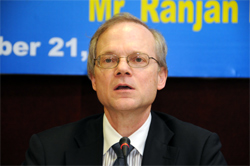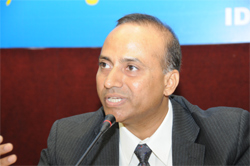You are here
The first session of the Dialogue focused on ‘Asymmetric Warfare and International Stability’. Chaired by Dr. Arvind Gupta, Lal Bahadur Shastri Chair at IDSA, the session had two presentations, one by Mr. Nigel Inkster of IISS and the second by Dr. S. Kalyanaraman of IDSA.
 Mr. Nigel Inkster focused on a new paradigm of conflict in the 21st Century which has a significant economic dimension where a range of actors are engaged in conflicts that fall short of a conventional warfare between states. Two manifestations of the new paradigm of conflict are Islamic jihadism and activity in the cyber domain. Exploring the first manifestation, Inkster stated that South Asia has served as the main crucible of jihadism. Two major developments in the recent past appear to be significant road-marks pointing towards the eventual demise of Jihadism – the Arab awakening and the death of Osama bin Laden. There has not been enough evidence available of al-Qaeda successfully exploiting the uncertainties that have arisen as a consequence of the Arab awakening. Moreover, the appeal of jihadist ideology in the Islamic world as a whole has been in decline for sometime. The future of Jihadi activities depends on how our situation in Afghanistan evolves after 2014. The IISS’s assessment has not been optimistic thus far about any kind of political settlement or peaceful outcome. Pakistan will find itself relying more heavily on the Haqqani network and the Lashkar-e-Taiba (LeT) to help neutralize those Jihadist elements which have declared a war on Pakistan.
Mr. Nigel Inkster focused on a new paradigm of conflict in the 21st Century which has a significant economic dimension where a range of actors are engaged in conflicts that fall short of a conventional warfare between states. Two manifestations of the new paradigm of conflict are Islamic jihadism and activity in the cyber domain. Exploring the first manifestation, Inkster stated that South Asia has served as the main crucible of jihadism. Two major developments in the recent past appear to be significant road-marks pointing towards the eventual demise of Jihadism – the Arab awakening and the death of Osama bin Laden. There has not been enough evidence available of al-Qaeda successfully exploiting the uncertainties that have arisen as a consequence of the Arab awakening. Moreover, the appeal of jihadist ideology in the Islamic world as a whole has been in decline for sometime. The future of Jihadi activities depends on how our situation in Afghanistan evolves after 2014. The IISS’s assessment has not been optimistic thus far about any kind of political settlement or peaceful outcome. Pakistan will find itself relying more heavily on the Haqqani network and the Lashkar-e-Taiba (LeT) to help neutralize those Jihadist elements which have declared a war on Pakistan.
The second manifestation of conflict in the cyber domain, especially the internet, has proven to be a great leveller calling into question the state’s hold over its subjects and has also questioned state sovereignty. Since the barrier to entry into this domain has declined to the point of insignificance, a range of malign actors have been enabled to exercise unprecedented effects. Managing the cyber domain is a challenging issue for national governments as most of the Information Communication Technologies (ICT) is in the hands of the private sector. Given this, policy makers can no longer just contemplate these problems but must begin to address them on a pragmatic basis.
 In his presentation, Dr. Kalyanaraman argued that the term ‘asymmetric warfare’ was coined to include insurgent and terrorist campaigns that Western states have had to contend with in the course of interventions. Their engagement in asymmetric wars is a matter of choice, not a matter of necessity, and depends on whether their interests are sufficiently aroused and on whether their national capabilities and circumstances at a particular point in time permit them. Such a choice is not available for countries where such wars are mainly prevalent, especially in South Asia. Countries in the region have to contend with asymmetric wars waged both by domestic and foreign groups. Dealing with domestic insurgencies is part of nation-building and hence it is not helpful to use the word ‘war’ to describe a counter insurgency campaign. He contended that the essence of the Indian approach to counter-insurgency ‘is not so much the physical attrition of the insurgents but their psychological exhaustion over an extended period of time’. This is accompanied by political concessions and socio-economic measures that address popular grievances and aspirations. This approach is a product of democratic politics.
In his presentation, Dr. Kalyanaraman argued that the term ‘asymmetric warfare’ was coined to include insurgent and terrorist campaigns that Western states have had to contend with in the course of interventions. Their engagement in asymmetric wars is a matter of choice, not a matter of necessity, and depends on whether their interests are sufficiently aroused and on whether their national capabilities and circumstances at a particular point in time permit them. Such a choice is not available for countries where such wars are mainly prevalent, especially in South Asia. Countries in the region have to contend with asymmetric wars waged both by domestic and foreign groups. Dealing with domestic insurgencies is part of nation-building and hence it is not helpful to use the word ‘war’ to describe a counter insurgency campaign. He contended that the essence of the Indian approach to counter-insurgency ‘is not so much the physical attrition of the insurgents but their psychological exhaustion over an extended period of time’. This is accompanied by political concessions and socio-economic measures that address popular grievances and aspirations. This approach is a product of democratic politics.
Asymmetric warfare in South Asia is not always a purely domestic phenomenon. Pakistan employed asymmetric actors against India in October 1947, in 1965, and again since the 1990s. Stopping state sponsorship of terrorism is quite difficult as America has discovered even after providing more than $20 billion in aid to Pakistan as well as stepping up drone attacks within Pakistan.
He further argued that it is best not to conflate the terms insurgency and terrorism. Insurgents basically target the security forces and state apparatus and work to acquire popular support in order to eventually overthrow the government in power. But in the case of terrorism, the people are the targets. At the core of counter-terrorism strategy must be the physical attrition of terrorist groups. In conclusion, he stated that asymmetric warfare has not suddenly emerged as a new face of conflict in the post-cold war era but has been the predominant form of conflict for the last two centuries at the least.
In the subsequent discussion the following points were highlighted. India’s approach in dealing with insurgency is judicious as it has been using calibrated force against the insurgent groups. While democratic values of India are a useful instrument against the insurgencies, at the same time there has been a lack of strategy in the Indian approach to dealing with insurgencies. The necessity of distinct counter-insurgency and counter-terrorism strategies was also stressed. The threat of cyber crimes will be a major challenge to international security in the future.
